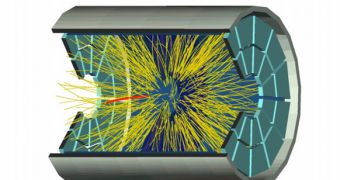A group of high-energy physics experts in the United States announces the production of 18 antinuclei of helium-4, the antimatter opposite of the common chemical element. This is a tremendous achievement and breakthrough in this branch of physics, analysts say.
Using data obtained from in-depth analysis of these nuclei could allow experts to understand why normal matter prevailed over antimatter shortly after the Big Bang, and why the Universe exists.
The best theories we have for explaining how everything came into existence after the initial event have a major flaw – they imply we shouldn't be here. If equal amounts of matter and antimatter were produced at the beginning of the Universe, why is it that normal matter endured?
The two should have theoretically canceled each other out in a few moments, but that obviously did not happen. Somewhere, an imbalance occurred, which allowed normal matter to win this “battle.”
Scientists hope that studies conducted on antimatter and its properties will help solve this mystery. The latest research is a part of these efforts. The investigation was carried out at the US Department of Energy's (DOE) Brookhaven National Laboratory (BNL).
Using the Relativistic Heavy Ion Collider's (RHIC) STAR detector, high-energy physicists were able to obtain no less than 18 antinuclei of helium-4. The particles were obtained from collisions of gold nuclei, carried out at energy levels of 200 gigaelectronvolts (GeV).
What the STAR Collaboration showed is that the element can exist in reality, and this is more important for elaborating new theories than actually getting a chance to study it in detail. The antihelium was produced from quark gluon plasma (QGP).
This is a state of matter that physicists believe permeated the early Universe only a few fractions of a second following the Big Bang, Technology Review reports. The material is made up of an approximately equal number of elementary particles called quarks and antiquarks.
Antihelium-3, the predecessor of the newly-found particles, was obtained in 1970, and it took more than 40 years to produce antihelium-4. RHIC scientists explain that it will take some time until the next antihelium is found. Current collider technology is insufficient to produce it, they add.
The BNL team is also happy to report that the production of this type of antimatter occurred exactly in the steps predicted by the standard theory of thermodynamics, and in accordance to the predictions made by the Standard Model of particle physics.
The work also indicates that antihelium-4 will never occur naturally, so there is no reason to waste resources looking for it. But there are also other implications that the study highlights.
“Any observation of antihelium or even heavier antinuclei in space would indicate the existence of a large amount of antimatter elsewhere in the Universe,” a STAR Collaboration press release says.

 14 DAY TRIAL //
14 DAY TRIAL //